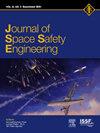Study of ionospheric response to geomagnetic storms on 27–29 May 2017 and 18–20 February 2014 along different longitudes
IF 1.7
Q3 ENGINEERING, AEROSPACE
引用次数: 0
Abstract
The study examines the change in the vertical total electron content (VTEC) and the presence of ionospheric irregularities during the geomagnetic storms that occurred on February 18–20, 2014 and May 27–29, 2017. TEC data from satellite receivers located in the equatorial and low latitude areas of the Americas, Pacific, Africa, and India were analyzed. In addition, magnetometer data, the Direct Penetration of Equatorial Electric Field Model (PPEEFM), interplanetary magnetic fields, and electric field data were also used. The Rate of TEC change (ROTI) was used to investigate changes in TEC caused by disturbances. The results indicate that there was a significant increase in TEC % over the Indian sector on 29 May 2017. Similarly, during the recovery phase of the storm there was an increase in TEC (about 240 %) over the Pacific sector which may attributed disturbances in the magnetosphere and ionosphere currents. During the geomagnetic storm on February 19–20, 2014, there were noticeable positive storm effects over the American sector, with TEC deviations of up to 220 %. After the main storm phase, the Pacific sector experienced TEC deviations of around 300 %. The study also found that ionospheric irregularities were suppressed in the American, African, and Indian sectors during the storm period in May 2017, while the geomagnetic storm of February 18–20, 2014 led to irregularities in these sectors, with complete suppression over the Pacific sector. This effect on irregularities is likely attributed to changes in IMF Bz components polarity and the associated amount of energy supplied to magnetosphere-ionosphere system during the geomagnetic storms in May 2017 and February 2014.
2017年5月27-29日和2014年2月18-20日不同经度电离层对地磁风暴响应的研究
研究了2014年2月18日至20日和2017年5月27日至29日发生的地磁风暴期间垂直总电子含量(VTEC)的变化和电离层不规则性的存在。从位于赤道和美洲、太平洋、非洲和印度低纬度地区的卫星接收器获得的TEC数据进行了分析。此外,还利用了磁力计数据、赤道电场直接穿透模型(PPEEFM)、行星际磁场和电场数据。用TEC变化率(Rate of TEC change, ROTI)研究干扰引起的TEC变化。结果表明,2017年5月29日,印度部门的TEC显著增加约150%。同样,在风暴恢复阶段,太平洋部分的TEC增加(约240%),这可能归因于磁层和电离层电流的扰动。2014年2月19-20日地磁风暴期间,美国扇区出现了明显的正向风暴效应,TEC偏差高达220%。在主风暴阶段过后,太平洋扇区经历了大约300%的TEC偏差。研究还发现,在2017年5月的风暴期间,美洲、非洲和印度扇区的电离层异常被抑制,而2014年2月18日至20日的地磁风暴导致这些扇区的电离层异常,太平洋扇区完全被抑制。这种对不规则性的影响可能归因于2017年5月和2014年2月地磁风暴期间IMF Bz分量极性的变化以及向磁层-电离层系统提供的相关能量。
本文章由计算机程序翻译,如有差异,请以英文原文为准。
求助全文
约1分钟内获得全文
求助全文
来源期刊

Journal of Space Safety Engineering
Engineering-Safety, Risk, Reliability and Quality
CiteScore
2.50
自引率
0.00%
发文量
80
 求助内容:
求助内容: 应助结果提醒方式:
应助结果提醒方式:


